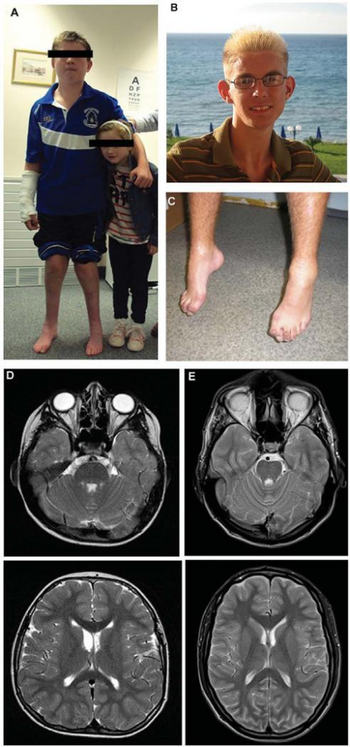Behr syndrome
| Behr syndrome | |
|---|---|
| Other names: Optic atrophy in early childhood, associated with ataxia, spasticity, mental retardation, and posterior column sensory loss | |
 | |
| Behr syndrome has an autosomal recessive pattern of inheritance. | |
Behr syndrome is characterized by the association of early-onset optic atrophy with spinocerebellar degeneration resulting in ataxia, pyramidal signs, peripheral neuropathy and developmental delay.[1][2]
Although it is an autosomal recessive disorder, heterozygotes may still manifest much attenuated symptoms.[3] Autosomal dominant inheritance also being reported in a family.[4] Recently a variant of OPA1 mutation with phenotypic presentation like Behr syndrome is also described.[5] Some reported cases have been found to carry mutations in the OPA1, OPA3 or C12ORF65 genes which are known causes of pure optic atrophy or optic atrophy complicated by movement disorder.[6]
Signs and symptoms

Onset : Early childhood
Progression: Chronic progressive
Clinical: Cerebellar ataxia plus syndrome / Optic Atrophy Plus Syndrome
Ocular: Optic atrophy, nystagmus, scotoma, and bilateral retrobulbar neuritis.
Other: Mental retardation, myoclonic epilepsy, spasticity, and posterior column sensory loss. Tremor in some cases.[7]
Musculoskeletal
Contractures, lower limbs, Achilles tendon contractures, Hamstring contractures, Adductor longus contractures[8]
Systemic
Hypogonadotrophic hypogonadism.[9]
Genetics
Behr syndrome is autosomal recessive which means the defective gene is located on an autosome, and two copies of the gene - one inherited from each parent - are required to be born with the disorder. The parents of an individual with an autosomal recessive disorder both carry one copy of the defective gene, but are usually not affected by the disorder. Autosomal dominant inheritance also being reported.[4]
Compound heterozygous mutations in OPA1 gene were reported.[5][10] Molecular genetic studies revealed a homozygous mutation in the C19ORF12 gene which has been previously reported in patients with mitochondrial membrane protein-associated neurodegeneration (MPAN) a variant of neurodegeneration with brain iron accumulation (NBIA).[6]
Pathology
Autopsy on one of the sister with Behr Syndrome revealed central atrophy of the optic nerves and total disarray of the normal laminar pattern of the lateral geniculate nucleus, dropout of neurons, and gliosis. There were numerous axonal spheroids in the neuropil. Similar spheroids with cell loss and gliosis were also observed in other thalamic nuclei and, rarely, in the pallida.[11]
Diagnosis
Diagnosis is suspected clinically and family history, neuroimaging and genetic study helps to confirm Behr Syndrome.[citation needed]
Neuroimaging
Diffuse, symmetric white matter abnormalities were demonstrated by magnetic resonance imaging (MRI) suggesting that Behr syndrome may represent a disorder of white matter associated with an unknown biochemical abnormality.[12]
Treatment
Management for this condition is supportive[citation needed]
See also
- List of systemic diseases with ocular manifestations
- Leber's Hereditary Optic Atrophy
- Mitochondrial Disorders
- Optic Atrophy Archived 2021-06-03 at the Wayback Machine
References
- ↑ synd/3048 at Who Named It?
- ↑ Behr C (1909). "Die komplizierte, hereditär-familiäre Optikusatrophie des Kindesalters: ein bisher nicht beschriebener Symptomkompleks". Klinische Monatsblätter für Augenheilkunde. 47: 138–60.
- ↑ Van Bogaert, L (1942). "Premiere observation anatomo-clinique de l'atrophie optique heredofamiliale compliquee de Behr". Bull. Acad. Roy. Med. Belg.
- ↑ 4.0 4.1 Felicio, Andre C.; Godeiro-Junior, Clecio; Alberto, Lucianna G.; Pinto, Aline P. M.; Sallum, Juliana M. F.; Teive, Helio G.; Barsottini, Orlando G. P. (2008-01-01). "Familial Behr syndrome-like phenotype with autosomal dominant inheritance". Parkinsonism & Related Disorders. 14 (4): 370–372. doi:10.1016/j.parkreldis.2007.08.008. ISSN 1353-8020. PMID 17977780.
- ↑ 5.0 5.1 Marelli, Cecilia; Amati-Bonneau, Patrizia; Reynier, Pascal; Layet, Valérie; Layet, Antoine; Stevanin, Giovanni; Brissaud, Etienne; Bonneau, Dominique; Durr, Alexandra (2011-04-01). "Heterozygous OPA1 mutations in Behr syndrome". Brain. 134 (Pt 4): e169, author reply e170. doi:10.1093/brain/awq306. ISSN 1460-2156. PMID 21112924.
- ↑ 6.0 6.1 Kleffner, Ilka; Wessling, Caroline; Gess, Burkhard; Korsukewitz, Catharina; Allkemper, Thomas; Schirmacher, Anja; Young, Peter; Senderek, Jan; Husstedt, Ingo W. (2015-10-15). "Behr syndrome with homozygous C19ORF12 mutation". Journal of the Neurological Sciences. 357 (1–2): 115–118. doi:10.1016/j.jns.2015.07.009. ISSN 1878-5883. PMID 26187298. S2CID 30246467.
- ↑ Schramm, P.; Scheihing, M.; Rasche, D.; Tronnier, V. M. (2005-06-01). "Behr syndrome variant with tremor treated by VIM stimulation". Acta Neurochirurgica. 147 (6): 679–683, discussion 683. doi:10.1007/s00701-005-0508-4. ISSN 0001-6268. PMID 15770348. S2CID 22966348.
- ↑ Copeliovitch, L.; Katz, K.; Arbel, N.; Harries, N.; Bar-On, E.; Soudry, M. (2001-08-01). "Musculoskeletal deformities in Behr syndrome". Journal of Pediatric Orthopedics. 21 (4): 512–514. doi:10.1097/01241398-200107000-00018. ISSN 0271-6798. PMID 11433166.
- ↑ Alfaro, José J.; Aparicio, Manuel; Quintana, Alicia; Barrio, Raquel (2002-05-25). "[Behr syndrome and hypergonadotropic hypogonadism]". Medicina Clínica. 118 (19): 759. doi:10.1016/s0025-7753(02)72522-0. ISSN 0025-7753. PMID 12049713.
- ↑ Bonneau, Dominique; Colin, Estelle; Oca, Florine; Ferré, Marc; Chevrollier, Arnaud; Guéguen, Naïg; Desquiret-Dumas, Valérie; N'Guyen, Sylvie; Barth, Magalie (2014-10-01). "Early-onset Behr syndrome due to compound heterozygous mutations in OPA1". Brain. 137 (Pt 10): e301. doi:10.1093/brain/awu184. ISSN 1460-2156. PMID 25012220.
- ↑ Horoupian, DS (1979). "Behr syndrome: a clinicopathologic report". Neurology. 29 (3): 323–7. doi:10.1212/wnl.29.3.323. PMID 571977. S2CID 33432542.
- ↑ Marzan, KA (1994). "MRI abnormalities in Behr syndrome". Pediatr Neurol. 10 (3): 247–8. doi:10.1016/0887-8994(94)90033-7. PMID 8060430.
External links
- Behr syndrome at NIH's Office of Rare Diseases
- Behr Syndrome at Omim.com Archived 2022-01-11 at the Wayback Machine
| Classification |
|---|
- Pages with script errors
- All articles with unsourced statements
- Articles with unsourced statements from October 2020
- Articles with invalid date parameter in template
- Webarchive template wayback links
- Autosomal recessive disorders
- Neurological disorders
- Rare syndromes
- Syndromes affecting the nervous system
- Genetic disorders with OMIM but no gene
- Syndromes affecting the eyes